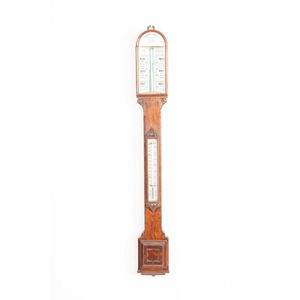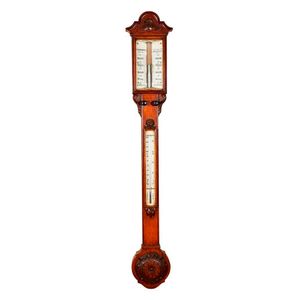Early Victorian Oak Stick Barometer
You must be a subscriber, and be logged in to view price and dealer details.
Subscribe Now to view actual auction price for this item
When you subscribe, you have the option of setting the currency in which to display prices to $Au, $US, $NZ or Stg.
- Oak - Native to Europe and England, oak has been used for joinery, furniture and building since the beginning of the medieval civilisation. It is a pale yellow in colour when freshly cut and darkens with age to a mid brown colour.
Oak as a furniture timber was superceded by walnut in the 17th century, and in the 18th century by mahogany,
Semi-fossilised bog oak is black in colour, and is found in peat bogs where the trees have fallen and been preserved from decay by the bog. It is used for jewellery and small carved trinkets.
Pollard oak is taken from an oak that has been regularly pollarded, that is the upper branches have been removed at the top of the trunk, result that new branches would appear, and over time the top would become ball-like. . When harvested and sawn, the timber displays a continuous surface of knotty circles. The timber was scarce and expensive and was used in more expensive pieces of furniture in the Regency and Victorian periods. - Victorian Period - The Victorian period of furniture and decorative arts design covers the reign of Queen Victoria from 1837 to 1901. There was not one dominant style of furniture in the Victorian period. Designers used and modified many historical styles such as Gothic, Tudor, Elizabethan, English Rococo, Neoclassical and others, although use of some styles, such as English Rococo and Gothic tended to dominate the furniture manufacture of the period.
The Victorian period was preceded by the Regency and William IV periods, and followed by the Edwardian period, named for Edward VII (1841 ? 1910) who was King of the United Kingdom and the British Dominions and Emperor of India for the brief period from 1901 until his death in 1910.
This item has been included into following indexes:
- barometers, period or origin
-
barometers, type
- barometers with thermometer 109
- stick 59
Visually similar items

Mexican sterling silver bread basket of rectangular wicker work form, with an undulating ropework border. Taxco, maker Villasana. Condition some minor denting & tarnishing. Length 32 cm. Weight 475

A late Victorian oak cased mercury stick barometer by Camerer Cuss, London, c.1900. Two glass fronted panels for Rise and fall with adjusting scales and a thermometer in Centigrade and Fahrenheit. Height 101 cm

A pair of modern sterling silver decanter coasters, each with turned mahogany wooden base & Hallmarks London. Diameter 12.5 cm

A fiddleback blackwood walking stick with carved ivory Bonzo dog, circa 1925, 88 cm
